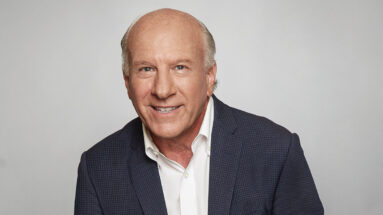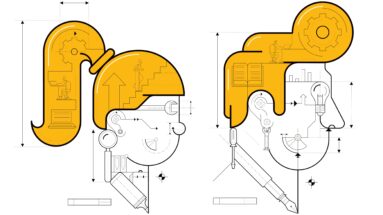March–April 2023
-

Your Calendar Needs More White Space
Magazine ArticleHighlights from this issue
-

Does Gamified Training Get Results?
Developing employees Magazine ArticleYes—under certain conditions.
-

Cat Owners Are More Cautious Consumers Than Dog Owners
Consumer behavior Magazine ArticlePeople unconsciously reflect their pets’ stereotypical traits.
-

GitLab’s CEO on Building One of the World’s Largest All-Remote Companies
Business management Magazine ArticlePractically from the start the company’s founders realized that colocation wasn’t necessary for success.
-

A Smarter Strategy for Using Robots
Operations strategy SpotlightAutomation should focus more on flexibility than on productivity.
-

Neurotech at Work
Business ethics SpotlightWelcome to the world of brain monitoring for employees.
-

AI with a Human Face
Web-based technologies SpotlightThe case for—and against—digital employees
-

Beware a Culture of Busyness
Time management Magazine ArticleOrganizations must stop conflating activity with achievement.
-

Redesigning How We Work
Adaptive leadership Magazine ArticleWe now know the postpandemic transition will take years. Leaders should acknowledge that—and start making plans for how to cope.
-

You Need Two Leadership Gears
Leadership Magazine ArticleKnow when to take charge and when to get out of the way.
-

The Hybrid Start-Up
Entrepreneurship Magazine ArticleA new-venture model that combines corporate and entrepreneurial capabilities
-

The New-Collar Workforce
Hiring and recruitment Magazine ArticleThere’s a huge, capable, and diverse talent pool out there that companies aren’t paying nearly enough attention to: workers without college degrees. It’s time for a skills-first approach to hiring and people management.
-

How Chinese Companies Are Reinventing Management
Business management Magazine ArticleThey prioritize autonomy at scale, internal digital platforms, and a clear project focus.
-

Fixing a Self-Sabotaging Team
Teams Magazine ArticleHow to spot and counter dysfunctional group behavior
-

What Psychological Targeting Can Do
Marketing Magazine ArticleAnd how to use it ethically
-

How High Achievers Overcome Their Anxiety
Managing yourself Magazine ArticleStrategies for escaping the most common “thought traps”
-

Case Study: Should a Dollar Store Raise Prices to Keep Up with Inflation?
Business management Magazine ArticleA discount retailer that’s struggling to maintain margins needs a new strategy.
-

Should You Quit Your Job?
Managing yourself Magazine ArticleAdvice on how to decide
-

Life’s Work: An Interview with Patti Smith
Personal growth and transformation Magazine ArticleThe ’70s icon looks back on her career in rock-and-roll and writing.
From the Editor
Idea Watch
Spotlight
Features
Experience
-
Does Gamified Training Get Results?
Developing employees Magazine ArticleCorporate training isn’t all fun and games, but maybe it should be. Most of us have (often grudgingly) used corporate learning systems. We skim through 50-slide PowerPoint decks hoping to correctly guess enough answers to pass so that we can get back to our “real work.” Much of what we learn is often forgotten by the time we receive our certificate of completion.
But a new study, conducted at the professional services firm KPMG, shows that gamified training done right—lessons conducted carefully and over time, incorporating elements such as progression through challenges and levels, instant feedback, points, and competition—can significantly improve employee performance.
View Details 8.95BUY REPRINT -
Cat Owners Are More Cautious Consumers Than Dog Owners
Consumer behavior Magazine ArticleA new series of studies shows that cat owners are drawn to products that reduce risk and prevent problems, while dog owners prefer products that promise gains. That has implications for the messages marketers craft and even for policy makers trying to influence consumer behavior.
View Details 8.95BUY REPRINT -
GitLab’s CEO on Building One of the World’s Largest All-Remote Companies
Business management Magazine ArticleWhen two software engineers decided, in 2013, to launch an enterprise software-as-a-service business around GitLab—the open-source collaborative software-development application that they’d been working on—they didn’t intend to turn it into the world’s largest all-remote organization. But they lived 2,000 kilometers apart—one in Ukraine and the other in the Netherlands—and their first hire was in Serbia. None of them wanted to move, so GitLab began its corporate life with a small, distributed workforce. As the founders began hiring more people, they made it official: The company would have no offices; employees could work from anywhere.
Today GitLab’s 2,000 team members are spread across some 60 countries and regions around the world. The company neither owns nor rents any corporate office space. Well before the Covid-19 pandemic hastened such a shift for other organizations, GitLab’s leaders embraced and developed best practices around virtual collaboration. They learned that success depends on measuring output, not input; aligning people on norms and values; ensuring that policies and processes are continually and openly documented; and reinforcing key self-management and people-management skills.
View Details 8.95BUY REPRINT -
A Smarter Strategy for Using Robots
Operations strategy SpotlightDespite advances in automation technology, the promise of productive and flexible automation, with minimal involvement of human workers, is far from reality, for two main reasons.
First, adoption of automation technology has been limited. Second, when firms do automate, what they gain in productivity they tend to lose in process flexibility, resulting in what the authors call zero-sum automation.
This article introduces positive-sum automation, which enables productivity and flexibility. To achieve it, companies must design technology that makes it easier for line employees to train and debug robots; use a bottom-up approach to identifying what tasks should be automated; and choose the right metrics for measuring success.
View Details 9.95BUY REPRINT -
Neurotech at Work
Business ethics SpotlightThe era of brain surveillance has begun. Although neuroscientists wrote off earlier iterations of neurotech devices as little better than toys, both the hardware and the software have improved dramatically, and neurotechnology has become more accurate and harder to dismiss. Today, the global market for neurotech is growing at a compound annual rate of 12% and is expected to reach $21 billion by 2026. This is not a fad. It’s a new way of living and thinking about ourselves and our well-being—personally and professionally.
In this article, the author provides an overview of the neurotechnology landscape and offers guidance on how companies should balance the risks and benefits of using neurotech devices in the workplace.
View Details 11.95BUY REPRINT -
AI with a Human Face
Web-based technologies SpotlightAll companies want to provide their customers with richer and more engaging experiences. The challenge is how to scale the experiences in a way that does not depersonalize or commodify them.
Enter the digital human. Rapid progress in computer graphics, coupled with advances in AI, is putting humanlike faces on chatbots and other computer-based interfaces. Digital humans now work in a range of roles such as sales assistant, corporate trainer, and social media influencer. They may not be as capable or versatile as human employees, but they have clear advantages in terms of cost, customizability, and scalability.
This article describes the various types of digital humans, looks at use cases, and presents examples of digital employees working in organizations today.
View Details 8.95BUY REPRINT -
Beware a Culture of Busyness
Time management Magazine ArticleOnce upon a time, leisure was a sign of prestige. Today that idea has been turned on its head, and busyness is the new status symbol. Busy people are considered important and impressive, and employees are rewarded for showing how “hard” they’re working. Such thinking is misguided. It can cause organizations to overload their employees, base their incentives on the amount of time they put in, and excessively monitor their activities, all of which undermine productivity and efficiency, research shows. Meanwhile, reducing work to manageable levels can actually enhance them.
This article explores both the downsides of busyness (employee turnover, reduced engagement, absenteeism, and impaired health) and the reasons for our obsession with it. It’s partly human nature: The harder we work to achieve something, the more we value it; most of us hate being idle; and we think customers like to see us busy. The authors also present strategies for breaking away from this fixation: Reward output, not activity. Eliminate low-value work to make time for “deep work.” Force people off the clock, and allow time for their minds to wander creatively. Model the right behavior, and build slack into your systems.
Activity is not achievement, and the sooner companies recognize that, the better off they and their employees will be.
View Details 8.95BUY REPRINT -
Redesigning How We Work
Adaptive leadership Magazine ArticleMany of us assumed that by now, years into the pandemic, we’d have settled on new structures, practices, and processes for hybrid work. But we haven’t. Instead most companies are stuck in a transitional phase, where little is resolved. Why is it taking us so long to work this out? Because, the author writes, the new world of hybrid work isn’t simply about determining whether everybody should come back full-time to the office. It’s also forcing us to test long-held assumptions about how work should be done and what it even is.
The changes to workplace practices and norms that we’re contemplating could be more significant than anything that’s happened in generations, Gratton writes, and we may need years to fully sort things out. So it’s time for leaders to start thinking differently about the problem and approach it just as they would any other major change in how they do business—by asking tough questions and learning deeply. Gratton surveys recent research on the pros and cons of hybrid work and offers leaders some fundamental questions they can use to guide their organizations into this new phase of redesigning how we work.
View Details 11.95BUY REPRINT -
You Need Two Leadership Gears
Leadership Magazine ArticleThe debate about the best way to lead has been raging for years: Should you empower your people and get out of their way, or take charge and push them to do great work? The answer, say the authors, is to do both. Their research shows that effective leaders routinely shift between these two seemingly opposing modes—and build teams whose members are good at switching back and forth too.
Sometimes teams need divergent thinking (during idea generation, for instance); at others, they need convergent thinking (to, say, make a decision and map out next steps). Leaders must be crystal clear about which mode is appropriate when. They have to make it psychologically safe for people to speak up, contribute, and argue, and when it’s time to end the discussion and act, signal that they’re taking charge again.
There are four ways to increase the ability to shift modes: Question your assumptions about power and fixed hierarchies. Study your habits and your team’s to see if you’re stuck in one mode or the other. Set clear expectations with meeting agendas and rituals that mark transitions. And reinforce shifts with your own words, deeds, and body language.
View Details 8.95BUY REPRINT -
The Hybrid Start-Up
Entrepreneurship Magazine ArticleCompared with start-ups, established corporations have many resources and capabilities that ought to give them a head start: customers, products, operations, licenses, distribution, marketing, and capital. But corporations lack one critical capability: the entrepreneurial muscle to take an idea from small to big, from zero to one.
The authors describe a new model—the hybrid start-up—which differs from typical internal corporate ventures. It combines the best of people, processes, and resources from both inside and outside the company. They show how many big companies are creating their own hybrid start-ups to unlock the value of their assets and defend their markets while becoming digital leaders. They draw on lessons from more than 190 such ventures launched over the past eight years with the help of BCG Digital Ventures, including those created by companies such as UPS (Ware2Go), Mercedes-Benz (RepairSmith), Volkswagen (Heycar), First American (Endpoint), AIA (Snackbox), Airbus (UP42), and others. The data provides strong evidence both that the model works and that hybrid start-ups are two or three times as likely to succeed as independent start-ups.
View Details 9.95BUY REPRINT -
The New-Collar Workforce
Hiring and recruitment Magazine ArticleMany workers today are stuck in low-paying jobs, unable to advance simply because they don’t have a bachelor’s degree. At the same time, many companies are desperate for workers and not meeting the diversity goals that could help them perform better while also reducing social and economic inequality. All these problems could be alleviated, the authors say, if employers focused on job candidates’ skills instead of their degree status.
Drawing on their interviews with corporate leaders, along with their own experience in academia and the business world, the authors outline a “skills-first” approach to hiring and managing talent. It involves writing job descriptions that emphasize capabilities, not credentials; creating apprenticeships, internships, and training programs for people without college degrees; collaborating with educational institutions and other outside partners to expand the talent pool; helping hiring managers embrace skills-first thinking; bringing on board a critical mass of nondegreed workers; and building a supportive organizational culture. IBM, Aon, Cleveland Clinic, Delta Air Lines, Bank of America, and Merck are among the companies taking this approach—and demonstrating its benefits for firms, workers, and society as a whole.
View Details 11.95BUY REPRINT -
How Chinese Companies Are Reinventing Management
Business management Magazine ArticleChina’s companies have long been acclaimed for their manufacturing prowess and, more recently, for their pragmatic approach to innovation. Now it’s time to recognize how they are reinventing the role of management through an approach the authors call “digitally enhanced directed autonomy,” or DEDA.
These companies use digital platforms to give frontline employees direct access to shared corporate resources and capabilities, making it possible for them to organize themselves around specific business opportunities. Autonomy is not complete, nor is it given to everyone. It is directed exactly where it is needed, and what employees do with their autonomy is carefully tracked. The approach contrasts with the Western model of empowerment, which gives employees broad autonomy through reduced supervision.
This article describes the three core features of the DEDA approach: granting employees autonomy at scale, supporting them with digital platforms, and setting clear, bounded business objectives. It offers examples of how companies are using those features and draws lessons for Western companies.
View Details 8.95BUY REPRINT -
Fixing a Self-Sabotaging Team
Teams Magazine ArticleTeams under pressure often fall back on dysfunctional coping mechanisms that are deeply rooted in human evolutionary psychology. The group works like a pack, instinctively looking for ways to alleviate its members’ collective anxiety. It might unconsciously ascribe an unwanted role, such as scapegoat or savior, to one or more members and lapse into skewed interactions—for example, directing its energy toward fighting a common enemy, whether real or perceived, rather than advancing its actual mission. The authors discuss how to spot these harmful patterns and break their hold. They describe a powerful tool deployed in their work with top teams: sociograms, or pictorial representations of team members, their connections, and their interactions. By understanding the unconscious forces that influence them in times of stress, teams can become less captive to such forces and more engaged with improving performance.
View Details 9.95BUY REPRINT -
What Psychological Targeting Can Do
Marketing Magazine ArticleControversy has swirled around psychological targeting—the practice of influencing people’s behavior by mining their digital footprints, identifying their personality traits, and then tailoring messages to them. Because it was misused to try to sway votes during recent elections, some have made it out to be a brainwashing tool. That’s simply a myth, explains Sandra Matz, a leading expert on it (who actually helped break the election story). Psychological targeting can’t radically change minds, she says. However, marketers can use it to shift opinions and attitudes, create demand where there was none, and engage with customers on a much more personal level. In this article she describes how companies can employ it in a way that creates the maximum value for them and their customers—and adheres to fundamental ethical principles.
View Details 11.95BUY REPRINT -
How High Achievers Overcome Their Anxiety
Managing yourself Magazine ArticleA surprising number of extremely successful people are often wracked by anxiety, the author writes. They suffer from what psychologists call thought traps and others might refer to as cognitive distortion or thinking errors: negatively biased and untrue patterns of thought that arrive automatically and often ensnare us, preventing us from seeing clearly, communicating effectively, or making good reality-based decisions. To combat thought traps, some anxious achievers turn to overwork, others to coping mechanisms such as substance use, avoidance, or passive-aggressiveness. Aarons-Mele explains the 11 most common thought traps—all-or-nothing thinking, labeling, jumping to conclusions, catastrophizing, filtering, discounting the positive, “should” statements, social comparison, personalization and blaming, ruminating, and emotional reasoning—and recommends strategies for overcoming all of them.
View Details 8.95BUY REPRINT -
Case Study: Should a Dollar Store Raise Prices to Keep Up with Inflation?
Business management Magazine ArticleDiscount retailer Dollar Bill’s has been struggling to maintain its margins over the past two years because of inflationary pressures, delays on imported goods, and decreased foot traffic. Now the board has asked CEO William Fisher Jr. to develop a strategy for raising prices. William worries that raising prices will hurt the company’s reputation and alienate customers, but he recognizes that something has to change.
Should Dollar Bill’s maintain the dollar price point by reducing product quantity, such as repackaging five-packs of chewing gum into four-packs for the same price? Or should it abandon the dollar price point and begin offering an array of more-expensive goods? This fictional case study features expert commentary by Greg Besner, the CEO of Sunflow, and Barrie Carmel, the vice president of pricing at Michaels Stores.
View Details 11.95BUY REPRINT -
Should You Quit Your Job?
Managing yourself Magazine ArticleThere are plenty of good reasons to quit a job. Maybe you want better pay, need to get away from a toxic boss, or are ready to pursue a different career. But quitting can be scary, because it also highlights what you stand to lose: the relationships you’ve cultivated with colleagues, the comfort of a familiar boss and organization, financial stability, sometimes even your sense of yourself as a gritty, resilient, loyal person.
This article reviews several new books—Quit: The Power of Knowing When to Walk Away; Two Weeks Notice: Find the Courage to Quit Your Job, Make More Money, Work Where You Want, and Change the World; and My What If Year: A Memoir—that offer advice for weighing the benefits and the costs of quitting.
View Details 8.95BUY REPRINT -
Life’s Work: An Interview with Patti Smith
Personal growth and transformation Magazine ArticleThe ’70s icon looks back on her career in rock and roll and writing, describing her unintended rise to fame, why she took a break from music, and how she became an award-winning author.
View Details 8.95BUY REPRINT





























































































